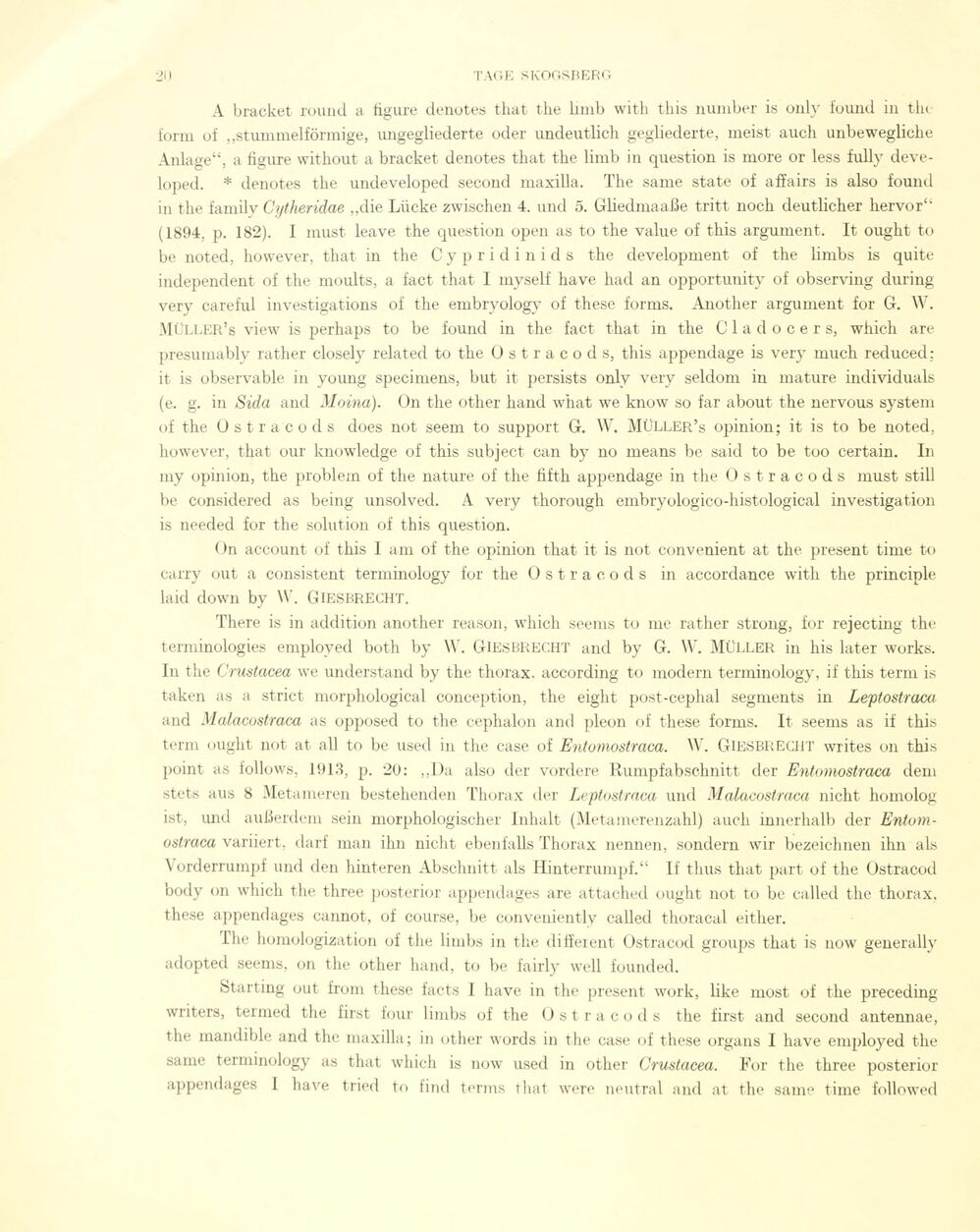
Full resolution (JPEG) - On this page / på denna sida - Sidor ...

<< prev. page << föreg. sida << >> nästa sida >> next page >>
Below is the raw OCR text
from the above scanned image.
Do you see an error? Proofread the page now!
Här nedan syns maskintolkade texten från faksimilbilden ovan.
Ser du något fel? Korrekturläs sidan nu!
This page has never been proofread. / Denna sida har aldrig korrekturlästs.
A bracket round a figure denotes that the limb with this number is only iound in tlic
form of „stummelförmige, ungegliederte oder undeutlich gegliederte, meist auch unbewegliche
Anlage“, a figure without a bracket denotes that the limb in question is more or less fully
deve-loped. * denotes the undeveloped second maxilla. The same state of affairs is also fourni
in the familv Cytheridae „die Lücke zwischen 4. und 5. Gliedmaaße tritt noch deutlicher hervor“
(1894. p. 182). I must leave the question open as to the value of this argument. It ought to
be noted, however, that in the Cypridinids the development of the limbs is quite
independent of the moults, a faet that I myself have had an opportunity of observing during
very careful investigations of the embryolog}7 of these forms. Another argument for G. W.
MÜLLER’s view is perhaps to be found in the faet that in the Cladocers, which are
presumably rather closely related to the Ostracods, this appendage is very mueh reduced:
it is observable in young specimens, but it persista only very seldom in mature individuals
(e. g. in Sida and Moina). On the other hand what we know so far about the nervous system
of the Ostracods does not seem to support G. W. MÜLLER’s opinion; it is to be noted,
however, that our knowledge of this subject can by no means be said to be too certain. In
my opinion, the problem of the nature of the fifth appendage in the Ostracods must still
be considered as being unsolved. A very thorough embryologico-histological investigation
is needed for the solution of this question.
On account of this I am of the opinion that it is not convenient at the present time to
carry out a consistent terminology for the Ostracods in accordance with the principle
laid down by W. GlESBRECHT.
There is in addition another reason, which seems to me rather strong, for rejecting the
terminologies employed both by W. GlESBRECHT and by G. \V. MÜLLER in his later works.
In the Crustacea we understand by the thorax, according to modern terminology, if this term is
taken as a strict morphological conception, the eight post-cephal segments in Leptostraca
and Malacostraca as opposed to the cephalon and pleon of these forms. It seems as if this
term ought not at all to be used in the case of Entomostraca. W. GlESBRECHT writes on this
point as follows, 1913, p. 20: „Da also der vordere Rumpfabschnitt der Entomostraca dem
stets aus 8 Metameren bestehenden Thorax der Leptostraca und Malacostraca nicht homolog
ist, und außerdem sein morphologischer Inhalt (Metamerenzahl) auch innerhalb der
Entomostraca variiert, darf man ihn nicht ebenfalls Thorax nennen, sondern wir bezeichnen ihn als
Vorderrumpf und den hinteren Abschnitt als Hinterrumpf.“ If thus that part of the Ustracod
body on which the three posterior appendages are attached ought not to be called the thorax,
these appendages cannot, of course, be conveniently called thoracal either.
The homologization of the limbs in the different Ostracod groups that is now generally
adopted seems, on the other hand, to be fairly well founded.
Starting out from these facts I have in the present work, like inost of the preceding
writers, termed the first four limbs of the Ostracods the first and second antennae,
the inaudible and the maxilla; in other words in the case of these organs I have employed the
same terminology as that which is now used in other Crustacea. For the three posterior
appendages I have tried to find terms that were neutral and at the same time followed
<< prev. page << föreg. sida << >> nästa sida >> next page >>